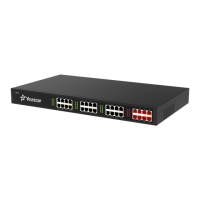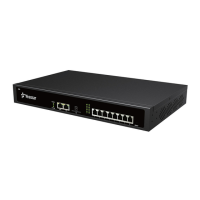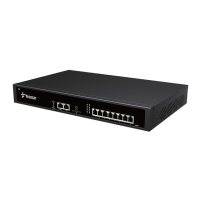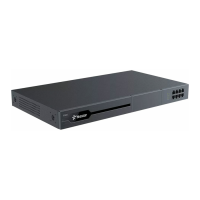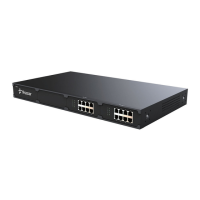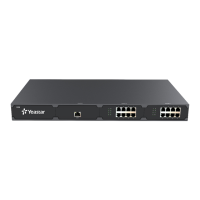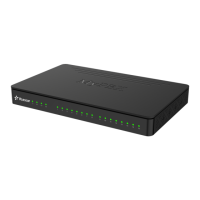
Do you have a question about the Yeastar Technology MyPBX Standard and is the answer not in the manual?
| Model | MyPBX Standard |
|---|---|
| SIP Trunks | Up to 8 |
| FXO Ports | Up to 4 |
| Dimensions | 226 x 152 x 44 mm |
| Weight | 0.8 kg |
| Music on Hold | Yes |
| Call Recording | Yes |
| Protocols | SIP, IAX2 |
| Voice Codecs | G.711, G.722, G.726, G.729, GSM |
| Video Codecs | H.263, H.264 |
| Fax Support | T.38 |
Lists the various features of MyPBX, covering telephony, network, and management capabilities.
Details the physical specifications, appearance, and LED indicators for MyPBX Standard and Pro models.
Illustrates the typical connection diagram for MyPBX Standard and Pro units, showing ports and external devices.
Explains the procedure for connecting the Ethernet cable to the MyPBX unit and checking the connection status.
Details the steps for connecting the MyPBX unit to a power outlet and verifying power supply.
Guides users on how to log in to the MyPBX web interface using default credentials and understanding user roles.
Provides an overview of the system's status, including line status, extension status, and trunk status.
Covers fundamental configuration settings, including extensions (FXS, VoIP) and trunk types (Analog, GSM, BRI, VoIP).
Configures how outgoing calls are processed through the trunks based on dial patterns.
Describes how to auto-provision IP phones after the Express Setup process, supporting various models.
Guides on managing inbound calls, including IVR, Queues, Ring Groups, and Inbound Routes.
Covers internal system settings such as general options, business hours, feature codes, SIP/IAX settings, voicemail, and SMS.
Configures network settings including LAN, WAN, Static Routes, Firewall, DHCP, VLAN, VPN, and DDNS.
Manages system settings including external storage, password, system prompts, date/time, backup/restore, and firmware updates.
Covers system reports, including call logs and system logs, for monitoring and troubleshooting.
Explains user prerequisites for MRI access and how to log into the MRI web interface.
Describes managing voicemail and recorded files, including checking, deleting, and downloading.
Configures voicemail passwords, email addresses for notifications, and sending voicemails as email attachments.
Covers basic settings like call forwarding, DND, and mobile extension numbers.
Explains how to access and research call logs using the CDR (Call Detail Records) interface.
Explains making outbound calls via PSTN and VoIP trunks, including sample routing configurations.
Explains how to handle incoming calls, including routing them to an IVR system.
Provides instructions for registering SIP softphones and IP phones with MyPBX.
Details the physical reset procedure and accessing the configuration page after a factory reset.
Covers security configurations for the web interface, including changing default ports and passwords.
Details changing the default root password for SSH access and disabling SSH if not needed.
Covers SIP port, guest calls, remote extensions, password enhancement, and IP restriction for extensions.
Provides steps to set up firewall rules for accepting local and remote network access and configuring auto blacklist rules.
Describes setting up a shared folder on a Windows machine with appropriate properties for Autobackup.
Details how to configure Autobackup settings on MyPBX using network share details like host, username, and password.
Explains NAT configuration for remote extensions when MyPBX is on a local network, including port forwarding.
Details NAT configuration for remote extensions when MyPBX has a public IP address, including network and NAT settings.
Guides on disabling local DHCP and enabling MyPBX DHCP server for successful auto-provisioning.
Details how to configure phones using the MyPBX auto-provision page and pop-up windows with MAC address and extension details.
Instructions for connecting and powering on the IP phone for auto-provisioning, including enabling DHCP on the phone.
Describes configuring distinctive ring tones on IP phones by associating text with specific ring tones.
Details how to map the distinctive ring tones configured on IP phones within MyPBX inbound routes.
Explains sending SMS messages via email with no PIN code using default or specific GSM ports.
Details sending SMS via email with a PIN code using default or specific GSM ports.
Explains configuring the DID Number for inbound routes to identify incoming calls and match patterns.
Sets the extension or destination for DID numbers, specifying how incoming calls are routed.
Explains how to select a specific PSTN line for outbound calls using BLF keys on Yealink IP phones.
Details the IP phone configuration to enable BLF key functionality for PSTN line selection.
